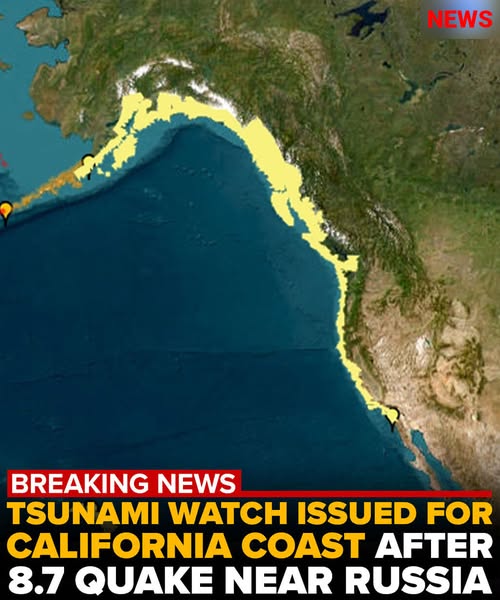
A massive magnitude 8.8 earthquake struck off the east coast of Russia’s Kamchatka Peninsula on Tuesday, prompting widespread tsunami warnings and advisories across the Pacific, including Hawaii, Alaska, parts of the U.S. West Coast, and Japan. According to the U.S. Geological Survey (USGS), the powerful quake occurred about 85 miles offshore at a depth of nearly 12 miles beneath the ocean floor. Initially reported at magnitudes of 8.0 and 8.7, the tremor was later upgraded to 8.8 as data from monitoring stations worldwide became available. Shortly after the initial quake, two strong aftershocks were recorded in the region, registering magnitudes of 6.3 and 6.9, adding to fears of additional seismic activity and potential underwater disturbances that could intensify tsunami threats. U.S. authorities quickly issued a tsunami warning for Alaska’s Aleutian Islands and Hawaii, while California, Oregon, and Washington were placed under a tsunami advisory as experts monitored wave activity across the Pacific. According to forecasters, if a tsunami wave forms, it could reach California’s coastline by 11:50 p.m. local time, with the Los Angeles area potentially impacted around 1 a.m. Huntington Beach officials preemptively closed beaches and piers, urging residents and visitors to stay away from the water as a precautionary measure. In Hawaii, officials warned that the first tsunami waves could arrive just after 7:15 p.m. local time, potentially bringing destructive surges capable of flooding coastal areas and generating powerful currents. The Hawaii Emergency Management Agency activated its Emergency Operations Center and Joint Information Center, working closely with Governor Josh Green’s team to coordinate safety measures. Statewide sirens sounded across all Hawaiian islands, continuing every hour for three hours to alert residents and visitors to evacuate coastal zones. Authorities urged people in low-lying areas, especially in Honolulu, to move inland or to higher ground, ideally to the fourth floor of sturdy buildings, to avoid potential floodwaters. The National Weather Service cautioned that tsunami waves often wrap around islands, putting all shores at risk. Officials warned that the danger could persist for hours after the first wave hits, as subsequent waves may be larger and more destructive than the initial surge. U.S. territories Guam and American Samoa were also placed under tsunami advisories, with emergency management agencies closely monitoring the situation. Across the Pacific, Japan’s meteorological agency issued tsunami advisories for coastal regions from Hokkaido to Kyushu. Authorities there predicted a wave approximately one meter (three feet) high could reach northern Hokkaido by 10 a.m. local time, with additional surges expected later along eastern Honshu and southern Kyushu. Residents were urged to stay away from beaches, river mouths, and coastal areas and not attempt to watch the incoming waves. Officials emphasized the seriousness of the warnings, noting that tsunami waves can cause dangerous flooding, sweep away structures, and create powerful currents capable of dragging people and vehicles into the ocean.
A tsunami warning indicates that dangerous and potentially life-threatening waves are expected imminently, while a tsunami advisory signals a possible risk that authorities are monitoring closely. Emergency agencies across affected regions remain on high alert as they continue to evaluate seismic activity and wave patterns throughout the Pacific Ocean. Residents and travelers in impacted areas are advised to stay tuned to official updates, follow evacuation orders promptly, and avoid coastlines until authorities declare the danger has passed.





